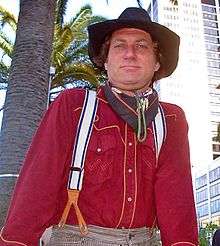Suspenders
Alternate meanings
Outside the United States the term suspenders, or suspender belt, refers to an undergarment used to hold up stockings. Somewhat confusingly this is called a garter belt in American, while in UK and Australian English a garter is a device to support or adorn a sock. It is important for the foreign reader to be aware of potential for confusion and embarrassment this may cause.

UK/Australia/NewZealand/South Africa
Suspenders or suspender belts, (known as "garter belts" in the USA), are an undergarment consisting of an elasticated material strip usually at least 2 to 3 inches (5.1 to 7.6 cm) in width; it can be wider. Two or three elastic suspender slings are attached on each side, where the material is shaped to the contours of the body. The suspenders are typically clipped to stockings with metal clips into which a rubber disc is inserted through the stocking material effectively 'locking' the stocking in place. These are normally attached to a length of elastic allowing for adjustment. These clips, also known as suspender slings, are best attached to stockings with a simple welt that do not have lace, or 'hold-ups' with a silicone rubber lining. Suspender (garter) belts are usually worn at the waist or just slightly below to prevent the belt sliding down as it is pulled downward by the stockings. Some undergarments such as corselettes or girdles may come with suspender slings attached.
USA and Canada
Suspenders (American English, Canadian English) or braces (British English, Australian English) are fabric or leather straps worn over the shoulders to hold up trousers. The straps may be elasticated, either entirely or only at attachment ends, and most straps are of woven cloth forming an X or Y shape at the back. Suspenders are typically attached to trousers with clips or buttons using leather tabs at the ends.

There have been several precursors to suspenders/braces throughout the past 300 years, but modern versions were first invented in 1820 by Albert Thurston. They were once almost universally worn, due to the high cut of mid-nineteenth and early twentieth century trousers that made a belt impractical. During the nineteenth century, they were sometimes called galluses.[1][2] Samuel Clemens, known for his work as the author Mark Twain, patented "Adjustable and Detachable Straps for Garments" (ADSG), becoming one of the first to receive a United States patent for suspenders/braces in 1871.[3] After losing popularity during World War I, when men became accustomed to uniform belts, they remained regular attire throughout the 1920s. Because of their image as 'underwear',[4] some men switched to belts during the 1930s as the vests (US/Canada) or waistcoats which had hidden suspenders became worn less often. This also signalled the switch in position of securing buttons from the outside of the waistband to the inside. Life magazine stated in 1938 that 60% of American men chose belts over suspenders. Though the return of fuller-cut trousers in the 1940s lead to a revival, they did not dominate over belts again to the same extent. However, in the UK braces remained the norm to wear with suits and dress trousers.[4][5]
Fashion
While passing in and out of fashion over the last century (alternating with belts in general preference), there has been a brief resurgence in interest, possibly due to the styles seen in films like Wall Street. Many business people, newscasters (such as Larry King in the United States)[6] and professionals[7] such as lawyers also still wear suspenders/braces.
Narrow, clip-on style suspenders/braces are also a typical part of skinhead, and to a lesser extent, punk fashion. In skinhead and punk fashion, suspenders/braces are typically between 3⁄4 and 1 inch (1.9 and 2.5 cm) in width.
Materials used for making suspenders/braces have also changed over time, with newer additions such as rayon, a hard-wearing synthetic fiber, now offered. The traditional Woollen Boxcloth braces remain available but are very costly, a style sometimes worn by senior lawyers in London. Generally, a high quality rayon with elastic webbing is the fabric used to create braces, with silks webbing or tubed suiting cloths from mills such as Dugdale Bros of England also used.[6]
Suspenders/braces can be measured in a variety of different ways to ensure proper fitting. To accurate measure suspenders/braces, first start by measuring from the back pant line, then cross over the opposite shoulder down to the front pant line. Add a few additional inches for adjustments when required. [8]
Usage
Good quality smart suspenders/braces were traditionally considered white collar, or upper or upper-middle class, wear. They were made to be attached to trousers by buttons sewn onto the waistband.[6] There are relatively few current manufacturers in the UK, but the classic button-on 'reform' end is also quite widely available in the United States.
In traditional or formal settings, it is considered a faux pas to wear both belt and suspenders/braces at the same time,[4][9] though in the past this has not always been the case. Further, they were traditionally considered an undergarment and, as such, were considered inappropriate to be seen.[4] From the time of their invention until World War II, the waistcoat, or a jumper or cardigan for coolness in the summer, covered suspenders/braces to prevent indecency. Similarly, jumpers and jackets kept the shirtsleeves hidden. In the inter-war period, however, men began removing jackets in public, and so this sensibility became eroded over time. It is perhaps only in Britain that a few 'die-hards' still consider it "gauche"[6] to wear, for example, brightly coloured suspenders without jacket. Generally, it is now considered acceptable fashion, on both sides of the Atlantic, for men's suspenders/braces to be seen.
The trousers for this use have buttons in order to attach the leather tabs; these may be either on the outside, traditionally, or inside of trousers that do not have belt loops. With belt loops, buttons would be sewn on the inside of the waistband. Such trousers might also have a high back in the fishtail shape, though this is not as common now;[6] This style may also have an additional adjustable strap at the back, as well as the two side adjusters placed on most belt-less trousers. Buttons should be placed about 3 to 3.5 inches (7.6 to 8.9 cm) apart, an equal distance from the back seam. At the front, the first button should be set over the main pleat or crease, the second button again about 3 to 3.5 inches (7.6 to 8.9 cm) apart. It is important to place the buttons in the correct position, as trousers with should remain slightly loose to hang correctly.
In the 2000s, it became fashionable for some younger women to wear suspenders/braces, a style that emerged from Mod styles in the late 1960s through to punk rock and skinhead styles of the late 1970s into the 1980s. One particular exponent of this fashion was Eurythmics vocalist Annie Lennox, whose fashion styling was akin to cross-dressing as a male character, with her dark business suits. Unisex fashion featured not only women wearing trousers and suspenders, but men in skirts with braces as an accessory .
References
| Wikimedia Commons has media related to Suspenders. |
- ↑ Jensen, Joan M. (1981). With these hands : women working on the land. Old Westbury, N.Y.: Feminist Press. p. 83. ISBN 9780912670904.
- ↑ "Fashion Glossary - G". The Internet Centre for Canadian Fashion and Design. Archived from the original on 30 January 2002. Retrieved 16 February 2013.
- ↑ "A Brief History of Suspenders", Retrieved 31 March 2014
- 1 2 3 4 Flusser, Alan (2002). Dressing the Man: Mastering the Art of Permanent Fashion. HarperCollins. pp. 221–225. ISBN 0-06-019144-9.
- ↑ "Nation Splits on Suspenders". Life. 1938-07-25. p. 41. Retrieved October 14, 2012.
- 1 2 3 4 5 Antongiavanni, Nicholas (2006). The Suit: A Machiavellian Approach to Men's Style. HarperCollins. pp. 154–5. ISBN 978-0-06-089186-2.
- ↑ Antongiavanni (2006). p. 41
- ↑ https://www.mrbowtie.ca/pages/measuring
- ↑ "Should I wear a belt when I wear suspenders?". men.style.com. April 2000. Archived from the original on 2008-12-22. Retrieved 2008-11-27. link rot